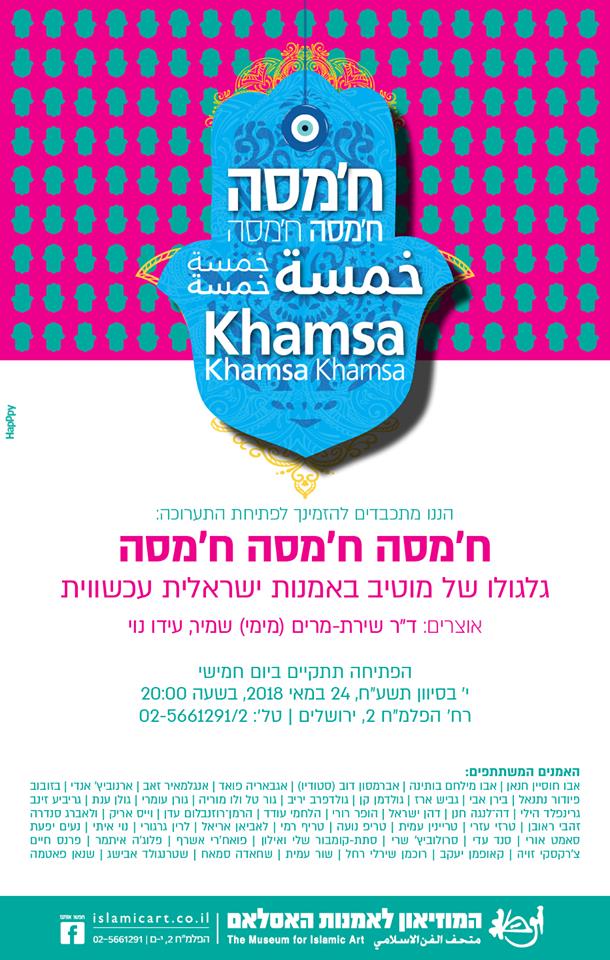« Khamsa, Khamsa, Khamsa » at the Jerusalem Museum for Islamic Art —
555 different Khamsas will be displayed in an exhibition, which is entirely devoted to the Khamsa, one of the most widespread motifs and artifacts in popular culture. Over the course of many years, the hamsa turned from a traditional object with a magical role – both in Moslem culture and Jewish culture – into an iconic object, which represent popular culture and art. In a process of cultural evolution Khamsa production became commercial and penetrated numerous areas of life: commercials and street billboards, business premises and public institutions, key holders and as an ornamental object in the car. Many strata of the population now use the Khamsa, and it has become an integral part of Israeli identity in 2018.
The exhibition is divided into three sections, each of which represents different portrayals of the Khamsa:
The first part comprises an extensive project specially devised for the exhibition, at the museum’s request. Some 50 artists and designers, from various fields, including: painting and sculpture, new media, visual communications, industrial design, product design, jewelry and Judaica, will present their new and contemporary rendition of the Khamsa.
The second part of the exhibition presents an extensive visual project based on a survey of hundreds of historic Khamsas from the private collection of Judaica collector William Gross, who is considered one of the world’s leading collectors of hamsas . As part of the project graphic designer Shirley Rachel Rochman “deconstructed” the different Khamsas in the collection to their visual and textual components, and identified patterns relating to form, symbols and ornamentation, including fish, flowers, lizards etc. These elements recur in various sequences. The research findings will be displayed in the exhibition, based on the infographics method, which will shed light on the design and origins of the Khamsa.
The third part of the exhibition comprises a unique exhibit of dozens of Khamsas which convey the incredible wealth of commercial Khamsas in Israel. The aim of this part of the exhibition is to illustrate the path the Khamsa has traveled, from a traditional artifact with a magical purpose, to an iconic object that represents popular art and culture, and which encompasses communities and sectors of the population. Some of the Khamsas were purchased from market stalls in the Old City of Jerusalem. Those are certainly aimed at tourists and, as the symbols and inscriptions on them indicate, are principally targeted at foreign tourists. In contrast, the curators find Khamsas designed for the local population at Everything for a Shekel stores on Jerusalem’s Jaffa Road, at stalls at Mahaneh Yehuda Market in Jerusalem, and the Carmel Market in Tel Aviv, the Flea Market in Jaffa and at the Ramla-Lod Market. Other Khamsas were brought from places “charged” with sacred significance, such as the Western Wall piazza, the graves of sages etc.
Designers and artists participating in the exhibition:
Buthina Abu Milhem, , Hannan Abu Hussein, Fouad Agbaria, Dov Abramson, Zev Engelmayer, Andi Arnovitz , Avi Biran, Feodor Netanel Bezzubov, , Erez Gavish, Ken Goldman, Yariv Goldfarb, Anat Golan, Tal Gur and Lou Moria , , Omri Goren, Zenab Garbia, , Hili Greenfeld, Chanan De-Lange, Israel Dahan, Rory Hooper, Oded Halahmy, Eden Herman- Rosenblumn, Arik Weiss, Sandra Valabregue, Reuven Zehavi, Ezri Tarazi, Amit Trainin, Noa Tripp, Rami Tareef, Ariel Lavian, Gregory Larin, Itai Noy, Yifat Naim, Uri Samet, Adi Sened, Sari Srulovitch, Shelly and Eilon Satat-Kombor, Ashraf Fawakhry, Itamar Paloge, Haim Parnas, Yaakov Kaufman, Shirley Rachel Rochman, Amit Shor, Samah Shihadi, Avishag Sterngold, Fatma Shanan.
The Jerusalem Museum for Islamic Art
HaPalmach St 2
Phone: 02-5661291
Dr Shirat-Miriam SHAMIR (Docteur en Arts et commissaire d’exposition) et Ido NOY

